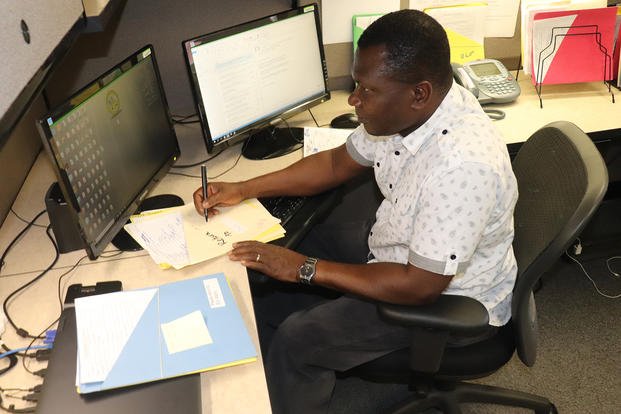Though many military members don't like the group physical training that is mandatory in some units, they tend to miss the added daily calorie burn when they transition to the civilian world.
These two former service members -- one a former Army infantryman, the other a former Navy submariner -- are facing the same problem: weight gain after service. But don't worry, we have some solutions and ways for veterans to stay fit.
Stew, I was in the infantry for eight years. Now, I work in an accounting firm where the only exercise I get at work is walking to and from my car in the parking lot. Any recommendations for adding in some activity while at work? I cannot get to the gym due to kids, school and commute. — Thanks, Rob (sedentary infantryman)
Stew, when I was on the sub for trips, I actually had a pretty good routine of working a scheduled shift, eating, sleeping and even working out. In fact, I got into decent shape when deployed. Now I am self-employed, and my schedule is work, work, work. I am doing it to myself, I know, but any advice for me? — Steven (Go Navy)
Although these readers have different situations and backgrounds, they basically have the same problem -- scheduling conflicts and finding physically creative ideas that work. Below are ideas to help squeeze fitness into a busy schedule so you can feel better, maintain fitness, work off stress and hopefully progress into making time for yourself to do some form of activity for 30-45 minutes a day.
Drink more water. Have water at your desk all day, as it will force you to take breaks often and you can loosen up tight muscles from the sitting posture, as well as burn calories by walking to and from the bathroom. Drinking more will force you to walk more.
Walk more. Find ways to take breaks every hour for even as little as five minutes and walk stairs, around the office or neighborhood and before or after meals. As you build up walking habits, you may find that an early morning or evening walk with the dogs, your spouse or kids is a great tool to manage weight and stress. Plus, you do not have to wear a ruck with this one -- so enjoy it.
Extra calisthenics, rubber bands and weights. If you can keep extra equipment at your office desk, try to add dumbbells and resistance bands to mix in some movements to work your arms, chest and shoulders. Adding in calisthenics like push-ups and squats is easy to do in a home office, an empty conference room or even the bathroom.
Keep extra equipment nearby and mix in work with training. If you have a home office, get a stationary bike for the office and check emails on your phone while biking.
Try to get a gym at work. Sometimes, all it takes is working an idea up the chain of command (human resources) to see whether gym equipment can be purchased. If you can get a work gym, a quick 20- to 30-minute workout and a 20- to 30-minute lunch is an idea for you. Also, getting to work earlier in the morning or staying a half-hour later to train in the gym could be helpful a few days a week. You might even avoid rush hour.
Don't forget the stand-up desk. You can burn more calories standing up than sitting down and have fewer issues compared to just sitting all day. Get one that is adjustable, as sometimes you can be more productive when sitting when on a tight deadline, for instance.
Special advice for the soldier turned accountant: Eventually, your schedule will open up, and you will have fewer demands on your time. Make sure you are not overeating, do some form of activity for stress relief, play with the kids and get a good night's sleep. Those will make you feel better and have more energy to train.
For the sailor turned entrepreneur: I get it. Being self-employed means you never leave work -- especially if you work from home -- but you have to take breaks. Don't start your day until you have exercised for 30 minutes.
You have to put it in the schedule; otherwise, it won't happen. It sounds like you like the set schedules from your previous life. Make your business more schedule-oriented. Get a morning workout in first thing. Eat something. Follow it up with the basic requirements of the job. Then work on new projects that require focus and creativity. Take a lunch break and walk for 20 minutes. Then get back to work or run errands. Finish up each day with a schedule for the next day and leave it on your desk -- ready to hit it tomorrow.
Stew Smith is a former Navy SEAL and fitness author certified as a Strength and Conditioning Specialist (CSCS) with the National Strength and Conditioning Association. Visit his Fitness eBook store if you’re looking to start a workout program to create a healthy lifestyle. Send your fitness questions to stew@stewsmith.com.
Want to Learn More About Military Life?
Whether you're thinking of joining the military, looking for fitness and basic training tips, or keeping up with military life and benefits, Military.com has you covered. Sign up for a free Military.com membership to have military news, updates and resources delivered directly to your inbox.














